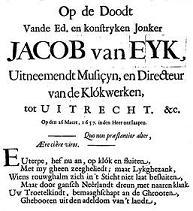|
Jacob van Eyck Quarterly |
2003, No. 1 (January) |
||
|
Lodewijk Meyer, a contemporary fan of Jacob van Eyck
|
|||
 |
In the first line, he invokes the muse Euterpe. The first volume of van Eyck's Der Fluyten Lust-hof initially appeared as Euterpe oft Speel-goddinne ('Euterpe, or the Goddess of Instrumental Music'). In the last part of the elegy, the poet finds comfort in van Eyck's compositional legacy. He mentions the Lust-hof, planted with 'many golden fruits', and is convinced that the deceased master 'shall live in the Netherlands through his sounds [compositions] as long as mankind in the Netherlands has ears.' This elegy clearly suggests more personal and musical involvement than the one by Lambertus Sanderus. | ||
| Lodewijk
Meyer (1629-1681) was a leading figure in the Dutch cultural and scholarly
life of his time. He was a philosopher, physician, philologist, lexicographer
(Nederlandsche woordenschat), poet and playwright. In 1660 he obtained
his doctorate in philosophy and medicine at Leiden University. Meyer was
a follower of Descartes and personally befriended with Spinoza. In 1669,
he was among the founders of the Amsterdam cultural society Nil Volentibus
Arduum. Meyer had an elder half-brother, Allardus Kók, who was
a professional musician.
Was Lodewijk Meyer an amateur recorder player, and did he play van Eyck's music himself? Probably. No final proof exists, but there is circumstantial evidence. After van Eyck's death, the Amsterdam music printer Paulus Matthysz launched a new instrumental collection: 't Konstigh Speeltooneel (3 volumes, 1657-1660) by the German composer Pieter Meyer.[1] For the third volume, Lodewijk Meyer wrote a panegyric on Pieter Meyer. (In spite of their common surname, they were not related.) Pieter Meyer for his part dedicated three charming duets to Lodewijk Meyer, which can also be found in the prefatory pages. [facsimile] Whereas the two-part Speel-tooneel was primarily meant for violin and bass, the duets are conceived for '2 Fluyten of Violinen' [2 recorders or violins]. [2]This leads us to believe that Lodewijk Meyer must indeed have been a recorder player. That Meyer was more than roughly acquainted with the original editions of Der Fluyten Lust-hof, can be concluded from the elegy's heading, which speaks of the 'Ed. en Konstryken Jonker Jacob van Eyk, Uitneemendt Musiçyn, en Directeur van de Klókwerken, tot UITRECHT, &c.' These words were clearly derived from the Lust-hof 's title pages. The spelling 'Eyk' instead of 'Eyck' can be found in the first edition of the second volume (1646) and the second edition of the first volume (1649). As Ruth
van Baak Griffioen has argued, Der Fluyten Lust-hof 'seems designed
with two main characteristics in mind: young and amateur.' [3]
Lodewijk Meyer perfectly fits in the profile. He was almost fifteen
years old when the first works by van Eyck were published in 1644. He
was 27 when van Eyck died. An interesting detail is that Lodewijk Meyer
grew up on the Bierkade in Amsterdam, a part of the Oudezijds Voorburgwal
between the Oudekerksplein and the Damstraat. The music shop of Paulus
Matthysz was practically around the corner! |
|||
|
[1] See Rudolf Rasch, 'P(i)eter Meyer, musician in Hamburg, Amsterdam, Sulzbach, and Hamburg', in Tijdschrift van de Vereniging voor Nederlandse Muziekgeschiedenis, XL/1 (1990), 36-74. [back] [2] Modern edition: Pieter Meyer, 't Konstigh Speeltooneel (Variations for Soprano Recorder; Preludium, Ballet & Courant for two Soprano Recorders), ed. Thiemo Wind (Amsterdam: Broekmans & Van Poppel, s.d.) Ed.No. 1622 [back] [3] Ruth van Baak Griffioen, Jacob van Eyck's Der Fluyten Lust-hof (1644-c1655), Utrecht 1991: 65. [back] |
|||
|
|
|||
| Thiemo Wind | |||
|
No. 2003/2 will be available on 1 April, 2003 Interested in receiving a reminder? Send an e-mail: Did you reach this page through a search engine? Click below to go to the |
|||